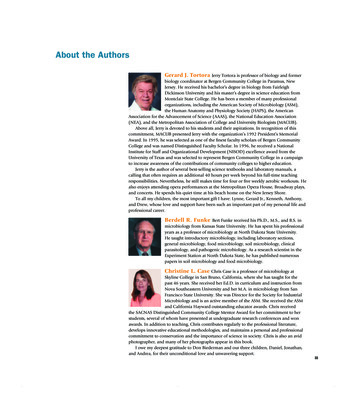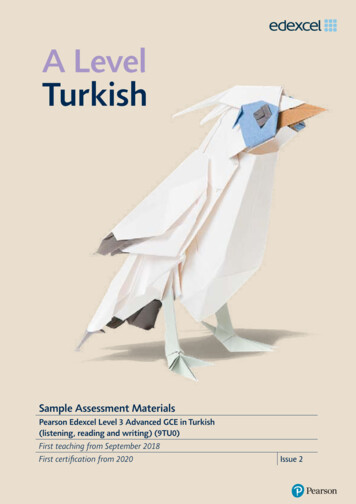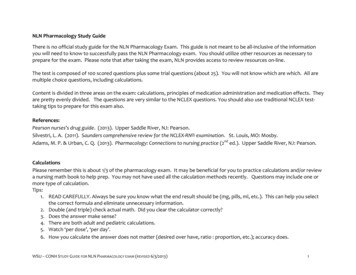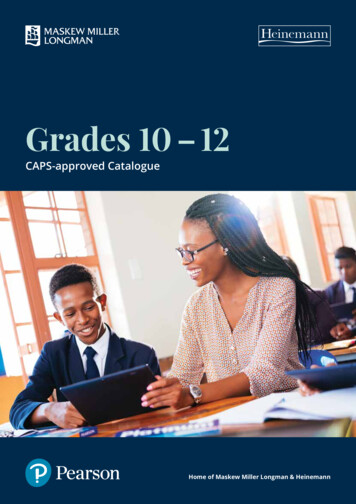
Transcription
A01 TORT5180 13 SE FM.indd Page 3 11/10/17 6:43 PM user/203/PH03334/9780134605180 TORTORA/TORTORA MICROBIOLOGY13 SE 9780134605180/SE/MAI .About the AuthorsGerard J. Tortora Jerry Tortora is professor of biology and formerbiology coordinator at Bergen Community College in Paramus, NewJersey. He received his bachelor’s degree in biology from FairleighDickinson University and his master’s degree in science education fromMontclair State College. He has been a member of many professionalorganizations, including the American Society of Microbiology (ASM),the Human Anatomy and Physiology Society (HAPS), the AmericanAssociation for the Advancement of Science (AAAS), the National Education Association(NEA), and the Metropolitan Association of College and University Biologists (MACUB).Above all, Jerry is devoted to his students and their aspirations. In recognition of thiscommitment, MACUB presented Jerry with the organization’s 1992 President’s MemorialAward. In 1995, he was selected as one of the finest faculty scholars of Bergen CommunityCollege and was named Distinguished Faculty Scholar. In 1996, he received a NationalInstitute for Staff and Organizational Development (NISOD) excellence award from theUniversity of Texas and was selected to represent Bergen Community College in a campaignto increase awareness of the contributions of community colleges to higher education.Jerry is the author of several best-selling science textbooks and laboratory manuals, acalling that often requires an additional 40 hours per week beyond his full-time teachingresponsibilities. Nevertheless, he still makes time for four or five weekly aerobic workouts. Healso enjoys attending opera performances at the Metropolitan Opera House, Broadway plays,and concerts. He spends his quiet time at his beach home on the New Jersey Shore.To all my children, the most important gift I have: Lynne, Gerard Jr., Kenneth, Anthony,and Drew, whose love and support have been such an important part of my personal life andprofessional career.Berdell R. FunkeBert Funke received his Ph.D., M.S., and B.S. inmicrobiology from Kansas State University. He has spent his professionalyears as a professor of microbiology at North Dakota State University.He taught introductory microbiology, including laboratory sections,general microbiology, food microbiology, soil microbiology, clinicalparasitology, and pathogenic microbiology. As a research scientist in theExperiment Station at North Dakota State, he has published numerouspapers in soil microbiology and food microbiology.Christine L. Case Chris Case is a professor of microbiology atSkyline College in San Bruno, California, where she has taught for thepast 46 years. She received her Ed.D. in curriculum and instruction fromNova Southeastern University and her M.A. in microbiology from SanFrancisco State University. She was Director for the Society for IndustrialMicrobiology and is an active member of the ASM. She received the ASMand California Hayward outstanding educator awards. Chris receivedthe SACNAS Distinguished Community College Mentor Award for her commitment to herstudents, several of whom have presented at undergraduate research conferences and wonawards. In addition to teaching, Chris contributes regularly to the professional literature,develops innovative educational methodologies, and maintains a personal and professionalcommitment to conservation and the importance of science in society. Chris is also an avidphotographer, and many of her photographs appear in this book.I owe my deepest gratitude to Don Biederman and our three children, Daniel, Jonathan,and Andrea, for their unconditional love and unwavering support.iii
A01 TORT5180 13 SE FM.indd Page 4 11/10/17 6:43 PM user/203/PH03334/9780134605180 TORTORA/TORTORA MICROBIOLOGY13 SE 9780134605180/SE/MAI .Digital AuthorsWarner B. Bair III Warner Bair is a professor of biology at LoneStar College–CyFair in Cypress, Texas. He has a bachelor of science ingeneral biology and a Ph.D. in cancer biology, both from the Universityof Arizona. He has over 10 years of higher education teaching experience,teaching both general biology and microbiology classes. Warner is therecipient of multiple educational awards, including the National Institutefor Staff and Organizational Development (NISOD) excellence award fromthe University of Texas and the League for Innovation in the Community College John andSuanne Roueche Excellence Award. Warner has previously authored Interactive Microbiology videos and activities for the MasteringMicrobiology website and is a member of the AmericanSociety for Microbiology (ASM). He is also a certified Instructional Skill Workshop (ISW)facilitator, where he assists other professors in the development of engaging and activeclassroom instruction. When not working, Warner enjoys outdoor activities and travel.Warner would like to thank his wife, Meaghan, and daughter, Aisling, for their support andunderstanding of the many late nights and long weekends he spends pursuing his writing.Derek Weber Derek Weber is a professor of biology andmicrobiology at Raritan Valley Community College in Somerville, NewJersey. He received his B.S. in chemistry from Moravian College and hisPh.D. in biomolecular chemistry from the University of Wisconsin–Madison. His current scholarly work focuses on the use of instructionaltechnology in a flipped classroom to create a more active and engaginglearning environment. Derek has received multiple awards for theseefforts, including the Award for Innovative Excellence in Teaching,Learning and Technology at the International Teaching and Learning Conference. Aspart of his commitment to foster learning communities, Derek shares his work at stateand national conferences and is a regular attendee at the annual American Society forMicrobiology Conference for Undergraduate Educators (ASMCUE). He has previouslyauthored MicroBooster Video Tutorials, available in MasteringMicrobiology, which remediatestudents on basic concepts in biology and chemistry as they apply to microbiology. Derekacknowledges the support of his patient wife, Lara, and his children, Andrew, James,and Lilly.iv
A01 TORT5180 13 SE FM.indd Page 5 11/10/17 6:43 PM user/203/PH03334/9780134605180 TORTORA/TORTORA MICROBIOLOGY13 SE 9780134605180/SE/MAI .PrefaceSince the publication of the first edition nearly 30 years ago, wellover 1 million students have used Microbiology: An Introduction atcolleges and universities around the world, making it the leadingmicrobiology textbook for non-majors. The thirteenth editioncontinues to be a comprehensive beginning text, assuming noprevious study of biology or chemistry. The text is appropriate forstudents in a wide variety of programs, including the allied healthsciences, biological sciences, environmental science, animal science, forestry, agriculture, nutrition science, and the liberal arts.The thirteenth edition has retained the features that havemade this book so popular: An appropriate balance between microbiologicalfundamentals and applications, and between medicalapplications and other applied areas of microbiology.Basic microbiological principles are given greater emphasis,and health-related applications are featured. Straightforward presentation of complex topics. Eachsection of the text is written with the student in mind. Clear, accurate, and pedagogically effective illustrationsand photos. Step-by-step diagrams that closely coordinatewith narrative descriptions aid student comprehension ofconcepts. Flexible organization. We have organized the book inwhat we think is a useful fashion while recognizing that thematerial might be effectively presented in other sequences.For instructors who wish to use a different order, we havemade each chapter as independent as possible and haveincluded numerous cross-references. The Instructor’s Guideprovides detailed guidelines for organizing the material inseveral other ways. Clear presentation of data regarding disease incidence.Graphs and other disease statistics include the most currentdata available. Big Picture core topic features. These two-page spreadsfocus on the most challenging topics for students tomaster: metabolism (Chapter 5), genetics (Chapter 8), andimmunology (Chapter 16). Each spread breaks down theseimportant concepts into manageable steps and gives studentsa clear learning framework for the related chapters. Eachrefers the student to a related MicroFlix video accessiblethrough MasteringMicrobiology. Big Picture disease features. These two-page spreads appearwithin each chapter in Part Four, Microorganisms andHuman Disease (Chapters 21–26), as well as Chapters 18(Practical Applications of Immunology) and 19 (Disordersof the Immune System). Each spread focuses on onesignificant public health aspect of microbiology. ASM guidelines. The American Society for Microbiologyhas released six underlying concepts and 27 related topics toprovide a framework for key microbiological topics deemedto be of lasting importance beyond the classroom. Thethirteenth edition explains the themes and competencies atthe beginning of the book and incorporates callouts whenchapter content matches one of these 27 topics. Doing soaddresses two key challenges: it helps students and instructorsfocus on the enduring principles of the course, and it providesanother pedagogical tool for instructors to assess students’understanding and encourage critical thinking. Cutting-edge media integration. m) provides unprecedented,cutting-edge assessment resources for instructors as well asself-study tools for students. Big Picture Coaching Activitiesare paired with the book’s Core Topics and Clinical Features.Interactive Microbiology is a dynamic suite of interactivetutorials and animations that teach key concepts inmicrobiology; and MicroBoosters are brief video tutorialsthat cover key concepts that some students may need toreview or relearn.New to the Thirteenth EditionThe thirteenth edition focuses on big-picture concepts andthemes in microbiology, encouraging students to visualize andsynthesize more difficult topics such as microbial metabolism,immunology, and microbial genetics.The thirteenth edition meets all students at their respectivelevels of skill and understanding while addressing the biggestchallenges that instructors face. Updates to the thirteenth editionenhance the book’s consistent pedagogy and clear explanations.Some of the highlights follow. Exploring the Microbiome. Each chapter has a new boxfeaturing an aspect of microbiome study related to thechapter. Most feature the human microbiome. The boxesare designed to show the importance of microorganisms inhealth, their importance to life on Earth, and how researchon the microbiome is being done. In the Clinic videos accompanying each chapter opener.In the Clinic scenarios that appear at the start of everychapter include critical-thinking questions that encouragestudents to think as health care professionals would invarious clinical scenarios and spark student interest in theforthcoming chapter content. For the thirteenth edition,videos have been produced for the In the Clinic featuresfor Chapters 1 through 20 and are accessible throughMasteringMicrobiology.v
A01 TORT5180 13 SE FM.indd Page 6 11/10/17 6:43 PM uservi/203/PH03334/9780134605180 TORTORA/TORTORA MICROBIOLOGY13 SE 9780134605180/SE/MAI .PREFACE New Big Picture disease features. New Big Picture featuresinclude Vaccine-Preventable Diseases (Chapter 18),Vertical Transmission: Mother to Child (Chapter 22), andBioterrorism (Chapter 24). Reworked immunology coverage in Chapters 17, 18, and19. New art and more straightforward discussions makethis challenging and critical material easier for students tounderstand and retain.Chapter-by-Chapter RevisionsData in text, tables, and figures have been updated. Other keychanges to each chapter are summarized below. Riboswitches are defined. A new box about tracking Zika virus is included.Chapter 9 Discussion of gene editing using CRISPR technology hasbeen added.Chapter 10 Rapid identification using mass spectrophotometry is included.Chapter 11 The genus Prochlorococcus is now included. The phylum Tenericutes has been added.Chapter 1 The resurgence in microbiology is highlighted in sections onthe Second and Third Golden Ages of Microbiology. The Emerging Infectious Diseases section has been updated. A discussion of normal microbiota and the humanmicrobiome has been added.Chapter 12 The classification of algae and protozoa is updated.Chapter 2 A discussion of the relationship between starch and normalmicrobiota has been added.Chapter 14 Discussions of herd immunity and the control of healthcareassociated infections are expanded. Clinical trials are defined. Congenital transmission of infection is included. Discussion of the emerging HAI pathogen Elizabethkingia isnow included. Epidemiological data have been updated.Chapter 3 Coverage of super-resolution light microscopy has beenadded.Chapter 4 The description of the Gram stain method of action has beenrevised. Archaella are now covered.Chapter 5 The potential for probiotic therapy using lactic acid bacteriais introduced. Reoxidation of NADH in fermentation is now shown inFigure 5.18.Chapter 6 Discussion has been added regarding the influence ofcarrying capacity on the stationary phase of microbial growth. Discussion of quorum sensing in biofilms is included. The plate-streaking figure is revised.Chapter 7 A new section on plant essential oils has been added.Chapter 8 The discussion of operons, induction, and repression hasbeen revised.Chapter 13 Baltimore classification is included. Virusoids are defined.Chapter 15 Genotoxin information is updated.Chapter 16 The discussion of the role of normal microbiota in innateimmunity is expanded. A table of chemical mediators of inflammation is included.Chapter 17 A new table listing cytokines and their functions has beenadded. Cells involved in cell-mediated immunity are summarized ina table.Chapter 18 Vaccine-preventable diseases are discussed in a new Big Picture. Coverage of recombinant vector vaccines has been added.Chapter 19 The discussion of autoimmune diseases has been updated. The discussion of HIV/AIDS has been updated. The Big Picture box has been revised to expand discussion ofdysbiosis-linked disorders.
A01 TORT5180 13 SE FM.indd Page 7 11/10/17 6:43 PM user/203/PH03334/9780134605180 TORTORA/TORTORA MICROBIOLOGY13 SE 9780134605180/SE/MAI .PREFACEChapter 20 Tables have been reorganized. Coverage regarding the mechanisms of action of antimicrobial drugs has been updated. In the Clinical Focus box, data on antibiotics in animal feedhave been updated.Chapter 25 All data, laboratory tests, and drug treatments are updated. Salmonella nomenclature has been revised to reflect CDCusage. Images of protozoan oocysts and helminth eggs have beenadded to illustrate laboratory identification.Chapter 21 All data are updated. The Big Picture on Neglected Tropical Diseases has beenrevised to include river blindness.Chapter 26 All data, laboratory tests, and drug treatments have beenupdated. STIs that do not affect the genitourinary system are crossreferenced to the organ system affected. Discussion of ocular syphilis is now included.Chapter 22 All data are updated. Coverage of Zika virus disease has been added. Discussion of Bell’s palsy has been added. A new Big Picture covering vertical transmission ofcongenital infections has been added.Chapter 23 All data are updated. The new species of Borrelia are included. Maps showing local transmission of vector-borne diseaseshave been updated.Chapter 24 All data, laboratory tests, and drug treatments have beenupdated. The emerging pathogen Enterovirus D68 is included. A new Big Picture covering bioterrorism has been added.Chapter 27 The concept of the Earth microbiome is introduced. Discussion of hydrothermal vent communities has beenadded. The discussions of bioremediation of oil and wastewaterhave been updated.Chapter 28 The discussion of industrial fermentation has been updated. The definition of biotechnology is included. A discussion of the iChip has been added. A table listing fermented foods has been added. Discussion of microbial fuels cells is now included.vii
A01 TORT5180 13 SE FM.indd Page 8 11/10/17 6:43 PM user/203/PH03334/9780134605180 TORTORA/TORTORA MICROBIOLOGY13 SE 9780134605180/SE/MAI .AcknowledgmentsIn preparing this textbook, we have benefited from the guidanceand advice of a large number of microbiology instructors acrossthe country. These reviewers have provided constructive criticism and valuable suggestions at various stages of the revision.We gratefully acknowledge our debt to these individuals. Specialthanks to retired epidemiologist Joel A. Harrison, Ph.D., M.P.H.for his thorough review and editorial suggestions.ContributorSpecial thanks to Janette Gomos Klein, CUNY Hunter College,for her work on Chapters 17, 18, and 19.ReviewersJason Adams, College of DuPageD. Sue Katz Amburn, Rogers State UniversityAna Maria Barral, National UniversityAnar Brahmbhatt, San Diego Mesa CollegeCarron Bryant, East Mississippi Community CollegeLuti Erbeznik, Oakland Community CollegeTod R. Fairbanks, Palm Beach State CollegeMyriam Alhadeff Feldman, North Seattle CollegeKathleen Finan, College of DuPageAnnissa Furr, Kaplan UniversityPattie S. Green, Tacoma Community CollegeJulianne Grose, Brigham Young UniversityAmy Jo M. Hammett, Texas Woman’s CollegeJustin Hoshaw, Waubonsee Community CollegeHuey-Jane Liao, Northern Virginia Community CollegeAnne Montgomery, Pikes Peak Community CollegeJessica Parilla, Georgia State UniversityTaylor Robertson, Snead State Community CollegeMichelle Scanavino, Moberly Area Community CollegeJohn P. Seabolt, University of KentuckyGinny Webb, University of South Carolina UpstateWe also thank the staff at Pearson Education for their dedicationto excellence. Kelsey Churchman guided the early stages of thisrevision, and Jennifer McGill Walker brought it across the finishline. Erin Strathmann edited the new Exploring the Microbiomeboxes, Chapters 17–19, and four new Big Picture spreads. MargotviiiOtway edited the new In the Clinic videos. Serina Beauparlantand Barbara Yien kept the project moving during a period of stafftransitioning.Michele Mangelli, Mangelli Productions, LLC, managedthe book from beginning to end. She expertly guided the teamthrough the editorial phase, managed the new design, and thenoversaw the production team and process. Karen Gulliver expertlyguided the text through the production process and managed theday-to-day workflow. Sally Peyrefitte’s careful attention to continuity and detail in her copyedit of both text and art served to keepconcepts and information clear throughout. The talented staff atImagineering gracefully managed the high volume and complexupdates of our art and photo program. Jean Lake coordinated themany complex stages of the art and photo processing and keptthe entire art team organized and on-track. Our photo researcher,Kristin Piljay, made sure we had clear and striking images throughout the book. Gary Hespenheide created the elegant interior designand cover. The skilled team at iEnergizer Aptara , Ltd moved thisbook through the composition process. Maureen Johnson prepared the index, Betsy Dietrich carefully proofread the art, whileMartha Ghent proofread pages. Stacey Weinberger guided thebook through the manufacturing process. A special thanks goes toAmy Siegesmund for her detailed review of the pages. LucindaBingham, Amanda Kaufmann, and Tod Regan managed thisbook’s robust media program. Courtney Towson managed theprint ancillaries through the complex production stages.Allison Rona, Kelly Galli, and the entire Pearson sales forcedid a stellar job presenting this book to instructors and studentsand ensuring its unwavering status as the best-selling microbiology textbook.We would like to acknowledge our spouses and families,who have provided invaluable support throughout the writingprocess.Finally, we have an enduring appreciation for our students,whose comments and suggestions provide insight and remind usof their needs. This text is for them.Gerard J. Tortora Berdell R. Funke Christine Case
A01 TORT5180 13 SE FM.indd Page 9 11/10/17 6:43 PM user/203/PH03334/9780134605180 TORTORA/TORTORA MICROBIOLOGY13 SE 9780134605180/SE/MAI .ContentsPART ONE Fundamentals of Microbiology1 The Microbial Worldand You 1Microbes in Our Lives 2The MicrobiomeNaming and Classifying Microorganisms 4Nomenclature Types of Microorganisms Classification ofMicroorganismsA Brief History of Microbiology 6The First Observations The Debate over SpontaneousGeneration The First Golden Age of Microbiology The Second Golden Age of Microbiology The Third GoldenAge of MicrobiologyMicrobes and Human Welfare 14Recycling Vital Elements Sewage Treatment: Using Microbesto Recycle Water Bioremediation: Using Microbes to CleanUp Pollutants Insect Pest Control by Microorganisms Biotechnology and Recombinant DNA TechnologyMicrobes and Human Disease 16Biofilms Infectious Diseases Emerging Infectious DiseasesStudy Outline Study Questions 2023 Observing MicroorganismsThrough a Microscope 51Units of Measurement 52Microscopy: The Instruments 52Light Microscopy Two-Photon Microscopy Super-ResolutionLight Microscopy Scanning Acoustic Microscopy ElectronMicroscopy Scanned-Probe MicroscopyPreparation of Specimens for Light Microscopy 61Preparing Smears for Staining Simple Stains DifferentialStains Special StainsStudy Outline Study Questions 694F unctional Anatomy of Prokaryoticand Eukaryotic Cells 72Comparing Prokaryotic and Eukaryotic Cells:An Overview 73THE PROKARYOTIC CELL 73The Size, Shape, and Arrangement of Bacterial Cells 73Structures External to the Cell Wall 75Glycocalyx Flagella and Archaella Axial Filaments Fimbriaeand PiliThe Cell Wall 80Chemical Principles 24The Structure of Atoms 25Chemical Elements Electronic ConfigurationsHow Atoms Form Molecules: Chemical Bonds 27Ionic Bonds Covalent Bonds Hydrogen Bonds MolecularMass and MolesChemical Reactions 30Energy in Chemical Reactions Synthesis Reactions Decomposition Reactions Exchange Reactions The Reversibility of Chemical ReactionsIMPORTANT BIOLOGICAL MOLECULES 31Inorganic Compounds 31Water Acids, Bases, and Salts Acid–Base Balance:The Concept of pHOrganic Compounds 33Structure and Chemistry Carbohydrates Lipids Proteins Nucleic Acids Adenosine Triphosphate (ATP)Composition and Characteristics Cell Walls and the Gram StainMechanism Atypical Cell Walls Damage to the Cell WallStructures Internal to the Cell Wall 85The Plasma (Cytoplasmic) Membrane The Movement ofMaterials across Membranes Cytoplasm The Nucleoid Ribosomes Inclusions EndosporesTHE EUKARYOTIC CELL 94Flagella and Cilia 96The Cell Wall and Glycocalyx 96The Plasma (Cytoplasmic) Membrane 97Cytoplasm 98Ribosomes 98Organelles 98The Nucleus Endoplasmic Reticulum Golgi Complex Lysosomes Vacuoles Mitochondria Chloroplasts Peroxisomes CentrosomeThe Evolution of Eukaryotes 102Study Outline Study Questions 103Study Outline Study Questions 47ix
A01 TORT5180 13 SE FM.indd Page 10 11/10/17 6:43 PM userx/203/PH03334/9780134605180 TORTORA/TORTORA MICROBIOLOGY13 SE 9780134605180/SE/MAI .CONTENTS5Microbial Metabolism 107Catabolic and Anabolic Reactions 110Enzymes 111Collision Theory Enzymes and Chemical Reactions Enzyme Specificity and Efficiency Naming Enzymes Enzyme Components Factors Influencing EnzymaticActivity Feedback Inhibition RibozymesEnergy Production 117Oxidation-Reduction Reactions The Generation of ATP Metabolic Pathways of Energy ProductionCarbohydrate Catabolism 119Glycolysis Additional Pathways to Glycolysis CellularRespiration FermentationLipid and Protein Catabolism 133Biochemical Tests and Bacterial Identification 134Photosynthesis 135The Light-Dependent Reactions: Photophosphorylation The Light-Independent Reactions: The Calvin-Benson CycleA Summary of Energy Production Mechanisms 138Metabolic Diversity among Organisms 138Photoautotrophs Photoheterotrophs Chemoautotrophs ChemoheterotrophsMetabolic Pathways of Energy Use 140Polysaccharide Biosynthesis Lipid Biosynthesis Amino Acidand Protein Biosynthesis Purine and Pyrimidine BiosynthesisThe Integration of Metabolism 143Study Outline Study Questions 14567 he Control of MicrobialTGrowth 178The Terminology of Microbial Control 179The Rate of Microbial Death 180Actions of Microbial Control Agents 180Alteration of Membrane Permeability Damage to Proteinsand Nucleic AcidsPhysical Methods of Microbial Control 182Heat Filtration Low Temperatures High Pressure Desiccation Osmotic Pressure RadiationChemical Methods of Microbial Control 187Principles of Effective Disinfection Evaluating a Disinfectant Types of DisinfectantsMicrobial Characteristics and Microbial Control 198Study Outline Study Questions 2008Microbial Genetics 204Structure and Function of the Genetic Material 205Genotype and Phenotype DNA and Chromosomes The Flowof Genetic Information DNA Replication RNA and ProteinSynthesisThe Regulation of Bacterial Gene Expression 215Pre-transcriptional Control Post-transcriptional ControlChanges in Genetic Material 221Mutation Types of Mutations Mutagens The Frequencyof Mutation Identifying Mutants Identifying ChemicalCarcinogensGenetic Transfer and Recombination 229Microbial Growth 151The Requirements for Growth 152Physical Requirements Chemical RequirementsBiofilms 157Culture Media 159Chemically Defined Media Complex Media AnaerobicGrowth Media and Methods Special Culture Techniques Selective and Differential Media Enrichment CultureObtaining Pure Cultures 163Preserving Bacterial Cultures 164The Growth of Bacterial Cultures 165Bacterial Division Generation Time LogarithmicRepresentation of Bacterial Populations Phases of Growth Direct Measurement of Microbial Growth EstimatingBacterial Numbers by Indirect MethodsStudy Outline Study Questions 174Plasmids and Transposons Transformation in Bacteria Conjugation in Bacteria Transduction in BacteriaGenes and Evolution 237Study Outline Study Questions 2389 Biotechnology and DNATechnology 242Introduction to Biotechnology 243Recombinant DNA Technology An Overview of RecombinantDNA ProceduresTools of Biotechnology 245Selection Mutation Restriction Enzymes Vectors Polymerase Chain ReactionTechniques of Genetic Modification 248Inserting Foreign DNA into Cells Obtaining DNA Selecting aClone Making a Gene Product
A01 TORT5180 13 SE FM.indd Page 11 11/10/17 6:43 PM user/203/PH03334/9780134605180 TORTORA/TORTORA MICROBIOLOGY13 SE 9780134605180/SE/MAI .CONTENTSApplications of DNA Technology 254Therapeutic Applications Genome Projects ScientificApplications Agricultural ApplicationsSafety Issues and the Ethics of Using DNA Technology 262Study Outline Study Questions 265PART TWO A Survey of the Microbial World10 Classification ofMicroorganisms 269The Study of Phylogenetic Relationships 270The Three Domains A Phylogenetic TreeClassification of Organisms 274Scientific Nomenclature The Taxonomic Hierarchy Classification of Prokaryotes Classification of Eukaryotes Classification of VirusesMethods of Classifying and Identifying Microorganisms 277Morphological Characteristics Differential Staining Biochemical Tests Serology Phage Typing Fatty AcidProfiles Flow Cytometry DNA Sequencing DNAFingerprinting Nucleic Acid Hybridization PuttingClassification Methods TogetherStudy Outline Study Questions 29111 The Prokaryotes: DomainsBacteria and Archaea 295The Prokaryotic Groups 296DOMAIN BACTERIA 296Gram-Negative Bacteria 297Proteobacteria The Nonproteobacteria Gram-Negative BacteriaThe Gram-Positive Bacteria 312Firmicutes (Low G C Gram-Positive Bacteria) Tenericutes Actinobacteria (High G C Gram-Positive Bacteria)DOMAIN ARCHAEA 318Diversity within the Archaea 318MICROBIAL DIVERSITY 319Discoveries Illustrating the Range of Diversity 319Study Outline Study Questions 32112 The Eukaryotes: Fungi, Algae,Protozoa, and Helminths 323Fungi 324Characteristics of Fungi Medically Important Fungi FungalDiseases Economic Effects of FungiLichens 335Algae 337Characteristics of Algae Selected Phyla of Algae Roles of Algaein NatureProtozoa 341Characteristics of Protozoa Medically Important ProtozoaSlime Molds 346Helminths 347Characteristics of Helminths Platyhelminths NematodesArthropods as Vectors 355Study Outline Study Questions 35713Viruses, Viroids, and Prions 361General Characteristics of Viruses 362Host Range Viral SizeViral Structure 363Nucleic Acid Capsid and Envelope General MorphologyTaxonomy of Viruses 366Isolation, Cultivation, and Identification of Viruses 370Growing Bacteriophages in the Laboratory Growing AnimalViruses in the Laboratory Viral IdentificationViral Multiplication 372Multiplication of Bacteriophages Multiplication of AnimalVirusesViruses and Cancer 384The Transformation of Normal Cells into Tumor Cells DNA Oncogenic Viruses RNA Oncogenic Viruses Virusesto Treat CancerLatent Viral Infections 386Persistent Viral Infections 386Plant Viruses and Viroids 386Prions 388Study Outline Study Questions 389PART THREE Interaction betweenMicrobe and Host14 Principles of Diseaseand Epidemiology 393Pathology, Infection, and Disease 394Human Microbiome 394Relationships between the Normal Microbiota and the Host Opportunistic Microorganisms Cooperation amongMicroorganismsxi
A01 TORT5180 13 SE FM.indd Page 12 11/10/17 6:43 PM userxii/203/PH03334/9780134605180 TORTORA/TORTORA MICROBIOLOGY13 SE 9780134605180/SE/MAI .CONTENTSTh
papers in soil microbiology and food microbiology. Christine L. Case Chris Case is a professor of microbiology at Skyline College in San Bruno, California, where she has taught for the past 46 years. She received her Ed.D. in curriculum and instruction from Nova Southeastern University and her M.A. in microbiology from San Francisco State .











